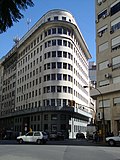
Avenida Presidente Julio Argentino Roca, better known as Diagonal Sur (Spanish for "South Diagonal", the counterpart to Diagonal Norte [1] ), is an important avenue in the Monserrat neighborhood of Buenos Aires, Argentina. It is oriented north-east/south-west, diagonally bisecting the city blocks (manzanas) which give the city centre a checkerboard plan. [2] It is named after President Julio Argentino Roca, who held power from 1880 to 1886, and from 1896 to 1904.







